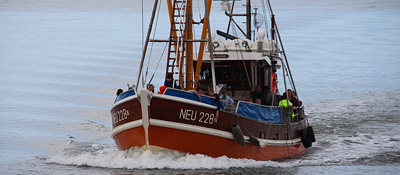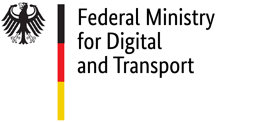Referat Nautik
Brandstwiete 1
20457 Hamburg
Oya Sönmez
Phone: +49 40 361 37-239
Fax: +49 40 361 37-204
Mobile: +49 171 88 53 239
Mail: oya.soenmez@bg-verkehr.de
BG Verkehr / Dienststelle Schiffssicherheit
Referat Schiffbau
Brandstwiete 1
20457 Hamburg

Alexander Dierichs
Phone: +49 40 361 37-244
Fax: +49 40 361 37-204
Mail: schiffbau@bg-verkehr.de
Detlef Rathke
Phone: +49 40 361 37-232
Fax: +49 40 361 37-204
Mail: schiffbau@bg-verkehr.de
Fishing vessels
- What is a fishing vessel?
- Miscellaneous Legislation
- Larger fishing vessels: European law
- Smaller fishing vessels: German law
- Stability and inclining tests
- Further information
What is a fishing vessel?
Fishing vessels are seagoing ships which are specially designed and equipped for catching fish, e. g.:
- Trawlers,
- Fish factory ships, equipped for the filleting, freezing and packing of fish,
- Cutters for inshore fishing,
- Ships engaged in high sea and deep sea fishing,
- Ships engaged in long line fishery.

Miscellaneous Legislation
The ship safety requirements for fishing vessels are established by various legal instruments, whose application depends on the length of the ship:
- Larger fishing vessels of 24 m length and above
- Smaller fishing vessels of less than 24 m length.
Larger fishing vessels are covered by European law
German-flagged fishing vessels of 24 m length and above have to comply with the European directive 97/70/EC. This directive implements the international convention on the safety of fishing vessels, 1977 (Torremolinos convention), as amended with the 1993 protocol in EU member states. The directive contains, in addition to general safety provisions, precise requirements regarding design, watertight subdivision and stability of the ship as well as regarding on-board machinery and electrical installations. Furthermore, the directive establishes requirements for fire protection, fire fighting equipment and life-saving equipment of fishing vessels. The International Convention for the Safety of Life at Sea (SOLAS), applicable to cargo ships, does not apply to fishing vessels.
The ship safety division of the BG Verkehr issues upon a survey a „Certificate of conformity“ to German-flagged fishing vessels of 24 m length and above if they comply with articles 3 and 5 of the European directive 97/70/EC. Normally an inclining test is also required. Furthermore, such fishing vessels must carry an equipment list on board, according to the specimen available from the ship safety division. The „Certificate of conformity“ and the equipment list must be renewed regularly.
All details on ship safety requirements can be found in the European directive 97/70/EC.
Smaller fishing vessels are covered by German law
German-flagged fishing vessels of less than 24 m in length are covered by German law. The German Schiffssicherheitsverordnung (Ship Safety Ordinance), annex 1a part 5, applies.
The actual requirements differ depending on the ship’s size, hull form, fishing gear and intended area of operation. Some requirements are different for open and for decked vessels. Most importantly, the fishing vessel must be adequately designed and constructed for the intended area of operation.
The details on ship safety requirements can be found in the Ship Safety Ordinance, annex 1a part 5.
If the survey of the ship has shown compliance with the provisions of this directive, the ship safety division of the BG Verkehr issues a safety certificate for fishing vessels, valid for a maximum of 5 years.
Stability and inclining Tests
With its Stabilitäts-Leitfaden (Stability Guidance), the Ship Safety Division of the BG Verkehr provides coherent practical advice and demonstrative diagrams and graphics on the topic stability of fishing vessels for coastal fishermen. "Kein Kutter darf kentern" (No fishing cutter should capsize) is not only the title but also the goal of this stability guidance.
The Stabilitäts-Leitfaden (Stability Guidance) consists of four parts:
- Part A contains various practical advice on how the stability of fishing vessels can be improved and what is dangerous.
- In Part B the depiction of seven accidents of fishing vessels demonstrates what can happen if crucial stability rules are not followed.
- In Part C the experts of the BG Verkehr explain the most important physical laws regarding stability.
- In Part D all practical advice is summarized in a checklist that is also available as a stand-alone document.
If a fisherman has not modified his fishing vessels of less than 24 m in length in a way that may affect the stability (e.g. installation of a new engine, a new trawl winch or something similar), upon application the control inclining test, which is required after 10 years, need not be done. In this case, the inclining test is only required after another 10 years. The application for a suspension of a control inclining test (in German only) must be made at the latest 6 months before the 10 year term runs out.
Fishermen are still obliged to inform the Ship Safety Division (Dienststelle Schiffssicherheit) if any conversions or other modifications relevant to the stability were carried out on the fishing vessel.
Further information on inshore and deep sea fishing
The website "Fischerei in Deutschland" (only in German language) offers additional information on inland, inshore and deep sea fishing.


